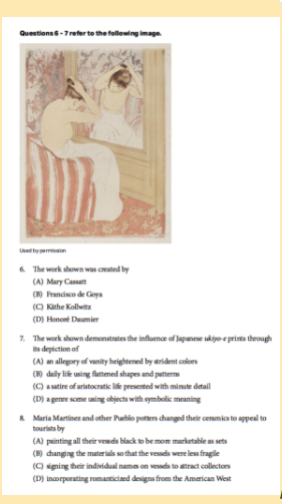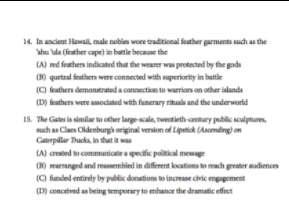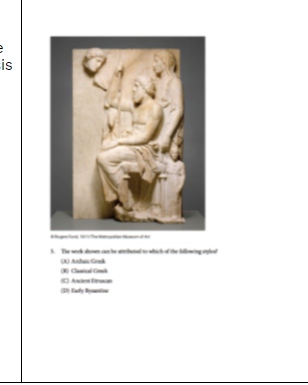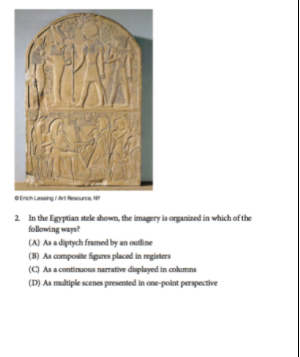AP Art History 🖼
34 resourcesSee Units
AP Art History Exam Guide
Format of the 2021 AP Art History Exam
The AP Art History Exam is made up of two sections:
Section 1: Multiple Choice (MCQ)
80 questions ➡️60 minutes ➡️50% of the exam score
Section 2: Free Response (FRQ)
6 questions (2 long & 4 short) ➡️120 minutes ➡️50% of the Exam score
Important Information about the 2021 exams:
- There will be paper and online administrations, (your school will decide which one you take)
- Online Exam: No going back on MCQ questions
- Online Exam: No Identifying of artworks on FRQ questions
The AP Art History Exam assesses content from the following skills learned throughout the course. Every question, whether it be multiple choice or free response, will use one of these art historical thinking skills.
The exam assesses content from 8 art history skills |
Skill 1: Visual Analysis Skill 2: Contextual Analysis Skill 3: Comparison of Works of Art Skill 4: Artistic Traditions Skill 5: Visual Analysis of Unknown Works Skill 6: Attribution of Unknown Works Skill 7: Art Historical Interpretations Skill 8: Argumentation |
The College Board has given us a basic breakdown of how much of each content area will be covered on the exam 📊:
Content Areas | Content Quantity & Exam Weighing |
Unit 1: Global Prehistory 30,000-500BCE | 11 artworks 4% |
Unit 2: Ancient Mediterranean 3500 BCE-300 CE | 36 artworks 15 % |
Unit 3: Early Europe and Colonial America 200-1750 CE | 51 artworks 21% |
Unit 4: Later Europe and Americas 1750-1980 CE | 54 artworks 21% |
Unit 5: Indigenous Americas 1000BCE-1980 CE | 14 artworks 6 % |
Unit 6: Africa 1100-1980 CE | 14 artworks 6% |
Unit 7: West and Central Asia 500BCE-1980 CE | 11 artworks 4 % |
Unit 8: South, East, and Southeast Asia 300 BCE-1980 CE | 21 artworks 8% |
Unit 9: The Pacific 700-1980 CE | 11 artworks 4% |
Unit 10: Global Contemporary | 27 artworks 11% |
Section 1: Multiple Choice Questions 🤓
80 questions ➡️60 minutes ➡️50% of the exam score
NOTE: If you’re taking the online exam, you will NOT be able to go back on the MCQ questions!
- Some questions will be grouped in sets (3-6 questions) and are based on color images.
- Some questions are individual questions, some may have a color image, some will have no images.
- Some questions will include images outside the 250 set.
Questions | Examples All of these questions can be found in the AP Art History Course and Exam Description. AP Central® |
About 40 questions are grouped in sets (3-6 questions) and are based on color images. |  |
About 40 questions are individual questions, some may have a color image, some will have no images. |  |
There will also be questions that include images outside the 250. These are usually attribution or visual analysis type questions |   |
Section 2: Free Response Questions 🤓
Questions | Examples All of these questions can be found in the AP Art History Course and Exam Description. AP Central® CLICK HERE to view example essays from the APAH CED |
Q1: Long Essay: Comparison
| This essay is assessing your ability to compare two works of art. College Board will provide you with the first work, then you select the second work. Here’s a simple breakdown of how to respond to this essay:
|
Q2: Long Essay: Visual/Contextual Analysis
| This essay is assessing your ability to visually and contextually analyze a work of art. Here’s a simple breakdown of how to respond to this essay:
|
Q3: Short Essay: Visual Analysis
| This essay is assessing your ability to visually analyze a work of art that is outside the 250.
|
Q4: Short Essay: Contextual Analysis
| This essay is assessing your ability to contextually analyze a work of art.
|
Q5:Short Essay: Attribution
| This essay is assessing your ability to attribute a work outside the 250.
|
Q6: Short Essay: Continuity and Change
| This essay is assessing your ability to analyze a work from the 250 set and the artistic tradition, style, and/or practice.
|
Questions 1, 3, 4, 5, and 6 will include images of works of art. |
Pre-work: set up your study environment
Before we begin reviewing 250 artworks, take some time to get organized.
📚 Organize your study materials.
Get your notebook, digital notebook, textbook, prep books, flash cards, or whatever other materials you have. Create a space where you can concentrate and have the least distractions. Start reviewing material that was first taught in the fall semester. Review the big ideas for each content area first, then review the specific artworks, less familiar to you.
Art history is a lot of notetaking, so start by reviewing the notes you’ve taken all year long, watching some videos over works less familiar, and spending time also looking closely at the works. Remember, visual analysis is going to show up on the test, and this is an area students struggle in.
Some additional advice would be to create REVIEW notes either on paper or digitally to help keep track of what artworks you’ve reviewed.
📅 Plan designated times for studying.
The hardest part about studying from home is sticking to a routine. Decide on one hour every day that you can dedicate to studying. This can be any time of the day, whatever works best for you. Set a timer on your phone for that time and really try to stick to it. The routine will help you stay on track.
🏆 Decide on an accountability plan.
How will you hold yourself accountable to this study plan? You may or may not have a teacher or rules set up to help you stay on track, so you need to set some for yourself. First set your goal. This could be studying for x number of hours or getting through a unit. Then, create a reward for yourself. If you reach your goal, then x. This will help you stay focused!
🤝 Get support from your peers.
There are thousands of students all over the world who are preparing for their AP exams just like you! Join our Discord channel to chat, ask questions, and meet other students who are also studying for the spring exams. You can even build study groups and review material together!
Browse Study Guides By Unit
🗿Unit 1 – Global Prehistoric Art, 30,000-500 BCE
🏛Unit 2 – Ancient Mediterranean Art, 3500-300 BCE
⛪️Unit 3 – Early European and Colonial American Art, 200-1750 CE
⚔️Unit 4 – Later European and American Art, 1750-1980 CE
🌽Unit 5 – Indigenous American Art, 1000 BCE-1980 CE
⚱️Unit 6 – African Art, 1100-1980 CE
🕌Unit 7 – West and Central Asian Art, 500 BCE-1980 CE
🛕Unit 8 – South, East, and Southeast Asian Art, 300 BCE-1980 CE
🐚Unit 9: The Pacific, 700–1980 ce
🏢Unit 10 – Global Contemporary Art, 1980 CE to Present
🙏Exam Reviews

Fiveable
Resources
© 2023 Fiveable Inc. All rights reserved.